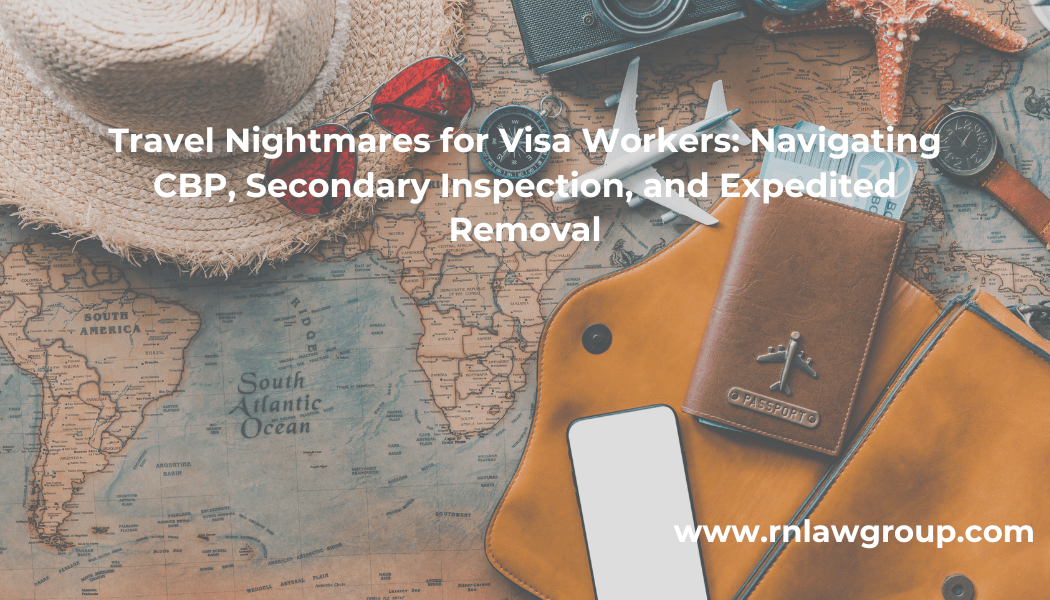
Travel Nightmares for Visa Workers: Navigating CBP, Secondary Inspection, and Expedited Removal
Foreign nationals working in the United States often assume that once they have secured a valid visa stamp in their passport, they are cleared for reentry. However, the process of being admitted into the United States involves a final, critical gatekeeper: U.S. Customs and Border Protection (CBP). Whether you are on an H-1B, L-1, O-1, or F-1 visa, entry into the U.S. is never guaranteed until CBP officially admits you. In fact, CBP has nearly total discretion for admission regardless of how clean your case is.
This article—based on insights from our recent Visa Vibes podcast—walks you through the border inspection process, explains what happens when things go wrong, and outlines strategies for responding to secondary inspections, expedited removal, and ongoing red flags.
The Role of CBP at the Port of Entry
The visa in your passport grants you the ability to travel to a U.S. port of entry and seek admission—but only CBP can determine whether you may enter the country. CBP officers at airports and land borders make this determination based on your visa classification, immigration history, and supporting documentation.
CBP views its responsibilities to include:
- Verifying identity and visa type
- Determining admissibility under the Immigration and Nationality Act (INA)
- Issuing or denying Form I-94, which governs your lawful period of stay
- Accessing databases such as PIMS (Petition Information Management Service)
- Conducting searches of public and private data (including devices and social media)
Even a small discrepancy—such as a job title that does not match your I-129 petition—can trigger additional scrutiny. CBP officers make their decision based not just on documentation, but on verbal responses, demeanor, and what they uncover during questioning or electronic device searches. Despite having valid USCIS and Department of State approvals, CBP can deny admission based on its own findings.
What Typically Happens at the Port
Upon arrival in the United States, most visa holders go through primary inspection, which includes:
- Scanning of passport and visa
- Fingerprint and photograph collection
- Basic questions regarding purpose of travel and employment
- Issuance of Form I-94, if admissible
Tens of thousands of travelers pass through primary inspection each day without issue. However, if there are red flags—such as a name match in a watchlist database, unclear visa usage, or an employer inconsistency—you may be referred to secondary inspection.
What Is Secondary Inspection?
Secondary inspection is an extended screening process conducted in a separate area of the port. It is often referred to as “immigration limbo”—you have not yet been admitted, but you have not been denied either. It allows officers additional time to investigate concerns before making a final decision.
What Happens in Secondary Inspection?
- CBP may call your employer or client to confirm your role and location.
- They may inspect your phone, laptop, and even cloud-linked apps for emails, texts, and social media messages.
- Officers often review deleted content, WhatsApp conversations, and banking transactions to verify payroll.
- They may review visa annotations, I-797s, and your digital footprint (e.g., LinkedIn).
- You are not permitted to call your attorney. There is no right to legal representation at this stage.
Secondary inspections can last from 30 minutes to 6 hours. Many individuals are simply vetted and cleared. However, in some cases, officers look for inconsistencies or perceived misrepresentations. Even a mismatch between your verbal answers and petitioned information (e.g., saying you work for the client rather than the petitioner) can raise concerns.
Sometimes, secondary inspection is fairly benign. For example, it is not uncommon for someone with an approved advance parole to be placed into secondary inspection simply because the officer is unsure about what the I-512L document actually does, but once they talk to a supervisor it is cleared up!
Key Tip: Bring physical copies of your I-797 approval, offer letter, pay stubs, and business cards. Know your exact job title, end-client (if any), and the address listed on your H-1B or LCA.
What Are Your Options If Things Go Wrong?
If CBP suspects you are inadmissible due to fraud, unauthorized employment, immigrant intent (on the wrong visa), or document issues, you could face denial of entry. Here are the key points to understand:
- You Do Not Have the Right to an Attorney: Secondary inspection is an administrative process. CBP officers are not required to allow attorney access or calls. That said, if you present a G-28, they might contact your attorney and at least provide updates.
- You May Request to Withdraw Your Application for Admission: If it appears that CBP is preparing to issue an expedited removal order, a traveler may request to voluntarily withdraw their application for admission. This:
- Avoids a five-year reentry bar under INA § 212(a)(9)(A)(i)
- Allows reapplication for a future visa without the stigma of removal
- Is entirely discretionary on the part of CBP
- You Should Not Lie or Guess: Inconsistent or incorrect responses—even if accidental—can be treated as misrepresentation. Instead, request clarification if confused. Never attempt to cover up uncertainty.
- After You Leave, You Should Take Action Immediately
- File a FOIA request with CBP for the inspection transcript if not already provided
- Contact immigration counsel immediately
- Document all details while fresh: officer names, timeframes, questions, documents reviewed
Post-Incident Options: Waivers and Redress
Whether you were removed or subjected to repeated scrutiny, there are legal avenues to pursue relief or correction.
- Form I-212: Application to Reapply for Admission After Removal If you are issued an expedited removal order, you are barred from reentry for 5 years. The I-212 waiver seeks permission to reapply before that bar expires.
When Is Form I-212 Required?
- Expedited removal at a port of entry
- Prior removal orders
- Voluntary return under removal terms
What Does the Waiver Require?
- Explanation of the events surrounding removal
- Evidence of rehabilitation and compliance
- Letters from employers and U.S. family ties
- Copies of prior filings and transcripts
- Information that would lead to a positive use of discretion.
There is no appeal of a denial. CBP has full discretion on these waivers.
- DHS TRIP: Traveler Redress Inquiry Program If you are frequently flagged or believe your name was wrongly placed on a watchlist, file a redress inquiry.
Who Should Use DHS TRIP?
- Travelers routinely pulled into secondary inspection
- Individuals misidentified due to name similarities
- People denied boarding without explanation
- Incorrect determinations by CBP can be brought up through DHS TRIP
How to File:
- Visit https://www.dhs.gov/dhs-trip
- Submit ID, travel documentation, and detailed explanations
- Receive a Redress Control Number for future use
Results are typically vague. DHS may update your records without specifying the changes, but a successful redress can reduce future delays. In cases where they made an incorrect determination, DHS might correct the records, but you still have to deal with the expedited removal issue.
Safeguarding Your Digital Life at the Border
CBP can search electronic devices without a warrant. As discussed in our article “Your Phone, Your Data,” these inspections can reveal deeply personal or professional content.
What Can Be Accessed:
- Emails, messaging apps, social media
- Photos and documents
- Cloud-stored content (if synced)
- Deleted data using forensic tools
Best Practices:
- Travel with clean or encrypted devices
- Avoid storing immigration-sensitive content
- Use alphanumeric passwords (avoid biometrics)
- Log out of apps and disable syncing
- Update LinkedIn to reflect accurate employment
Failure to cooperate may result in delayed entry or denial. Even without wrongdoing, the burden is on the traveler to prevent misunderstandings.
How to Avoid Travel Nightmares: Practical Tips
- Check your I-94 record at https://i94.cbp.dhs.gov immediately after every trip
- Carry printed documentation (I-797, pay stubs, offer letter)
- Avoid travel during pending amendments or extensions
- Make sure your driver’s license matches your work location
- Ensure consistency across resumes, petitions, and online profiles
- Only use automatic revalidation when clearly eligible (short trips to Canada/Mexico)
Conclusion
Travel problems for visa holders can arise unexpectedly and escalate quickly. While most international travelers are admitted without issue, it is critical to understand your rights, prepare thoroughly, and take swift action when problems arise.
At Reddy Neumann Brown PC, we help clients resolve CBP issues, file redress requests, and prepare Form I-212 waivers. If you have experienced problems at the port of entry, contact our office to discuss how we can help protect your ability to return to the U.S. and continue your immigration journey.
By: Steven Brown
Steven A. Brown is a Partner at Reddy Neumann Brown PC, where he leads the firm’s Litigation Team, addressing delays and denials of immigration benefits, FOIA requests, and policy and regulatory challenges. Steven is dedicated to delivering practical and effective solutions for clients facing unreasonably delayed or unlawfully withheld immigration benefits, including Employment Authorization Documents (EADs), advance parole, green cards, 221(g) decisions, EB-5 delays, and other immigration-related matters. His litigation efforts were instrumental in Shergill, et al. v. Mayorkas, a landmark case that led to the U.S. government recognizing that under the INA, L-2 and E visa spouses are authorized to work incident to their status, eliminating the need for separate EAD applications. This case has transformed work authorization for thousands of families across the United States.

